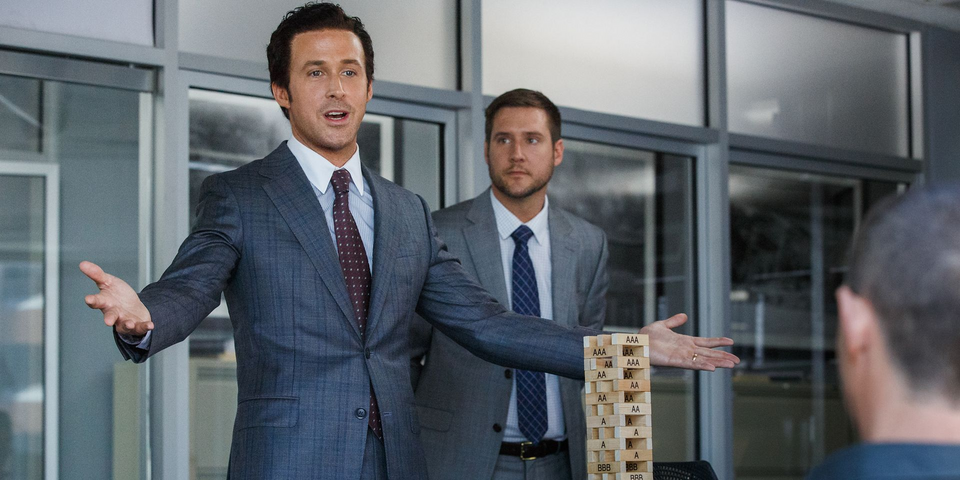What happened in "The Big Short" movie? Novice investor explanation

If you've just watched "The Big Short" movie and didn't understand a thing, then you're in the right place. Here we'll figure out what happened in the movie, what stands for all those CDS and MBS, and why Mark Baum was so pissed off.
"The Big Short" is a captivating and informative film that explores the complexities of the 2008 financial crisis. But if you watched it, you know that.
What you don't know is how the financial crisis formed, what actions were made by financial experts in the movie and why, and how it all may relate to your investing experience. But let's start from the very beginning – the name of the movie.
What does “The Big Short” or “to short the market” mean?
"Shorting" the market is a strategy used in investing when a person bets that the value of an asset will decrease. It involves borrowing an asset from someone else and selling it at the current market price. The goal is to buy back the asset at a lower price in the future, return it to the lender, and profit from the difference in price.
Here is a simplified example:
Let's say you have $1. You spend that $1 to borrow the asset and sell it for $10 because you expect its price to go down. You now have $10 from the sale, but you still owe the lender the loaned asset. Later, the price of the asset falls, as expected, and you buy it back for $3. As a result, you made a profit of $7 ($10 from the sale of the asset - $3 spent on its redemption).
So you started with $1, sold short, and ended up making $7 in profit. That's the way to go!
Of course, the process is more complicated, with additional costs and nuances, but this is the basic idea. Now let's delve into the movie itself.
The plot development

"The Big Short" introduces us to a group of financial experts: Michael Burry, Mark Baum, Jared Vennett, and Charlie Geller, who noticed something unusual happening in the housing market before the 2008 financial crisis. They observed that banks gave loans to people who couldn't afford them. This practice led to an increase in people defaulting on their mortgage payments.
By understanding the situation on the market, we can grasp how these risky mortgage loans were bundled together and sold as complex financial products, and how this led to the big financial crisis of 2008.
A closer look at the market situation
At the time depicted in the movie, the housing market seemed to be on the rise. Banks and other financial institutions provided mortgage loans to people who could not always afford them. These loans were then bundled and sold as complex investment products known as mortgage-backed securities (MBS).
A super simple explanation of MBS:
Imagine that you have come to a dinner party, and each guest brings his own dish. The host decides to mix all the dishes together and serve them as one casserole. Mortgage-backed securities (MSEs) combine several mortgage loans into one investment, like a casserole. If one dish (mortgage) goes bad, it can affect the whole casserole (securities).
CDOs creation: ignorance is (not) a bliss
In the movie, Jared Vennett saw an opportunity to take advantage of the fact that the housing market was a bubble by creating and selling CDOs.
A super simple explanation of CDO:
Collateralized debt obligations (CDOs) can be compared to a multi-layered pie. Each layer represents a different level of risk associated with the underlying mortgage loans. The top layer is the least risky, while the bottom (subprime) is the most risky. If the bottom layer collapses, it can cause the entire cake to fall.
CDOs mirror the structure of bonds where investors lend money to companies or governments in exchange for regular interest payments and repayment of principal.
By creating CDOs, Vennett gave investors access to the housing market and its risks. He offered these CDOs to investors who were either unaware of the risks associated with the underlying assets or believed that the market would continue to rise.
So, for Vennett, the ignorance of these investors was bliss. For them – the opposite. In the market, it will always be like this: whoever is smarter or has more information will win.
All the securities and derivatives involved in this system were interconnected in a way that a collapse in the housing market would have profound consequences for the entire financial system. It was only a matter of time before this trap was realized, which the movie's main characters successfully did.
Not only did they see the crisis coming, but they also knew how to use this situation to their advantage (here comes the mysterious CDS!).
Betting against the market

To maximize potential profits from the impending housing collapse, Michael Berry, Mark Baum, Jared Vennett, and Charlie Heller purchased credit default swaps (CDS).
CDS are financial instruments that serve as insurance against the default of a package of mortgage loans. By buying CDS contracts, they were essentially betting that these mortgage-backed securities would default, allowing them to profit from the insurance payout. The use of CDS is an example of how investors can hedge their positions or speculate on the probability of certain events occurring in the market.
A super simple explanation of CDS:
Imagine that you loan $100 to your friend Jack, but you know that he almost never pays back the debt. To protect yourself from the risk of not getting your money back, you decide to hedge that risk.
You go to Broke Friends Bank and buy a CDS contract from them for $20. If Jack, as usual, disappears and does not return the loan, Broke Friends Bank will step in and pay off the debt on his behalf. They can pay it off with interest.
*You don't even have to be the person who loaned the money to Jack to buy a CDS on his defaulting. You might just be an observer who believes that Jack will spend all the money and disappear, leaving the borrower penniless. But you who just bought CDS will win from it.
When the housing market collapsed, the companies that issued the CDS for the film's characters had to pay them huge compensation.
Phew, that was hard! For me too, actually. To understand and explain the movie "The Big Short" is a big challenge, believe me.
I hope you understand what happened in the movie, what led to the 2008 crisis, and how the characters were able to benefit from it. And now let's go to the main thing – learning. Every crisis is an opportunity to learn, so let's do it to be more mindful in our investment decisions and not succumb to the "gold rush".
Investor’s lessons: learning from mistakes
- Understand the market and do thorough research
Especially when you're just starting out, it's important to get a basic understanding of the financial market and how investing works. Bakksy's free education bot for beginners is an excellent starting point to build your investment knowledge and gain valuable experience.
- Think critically
Don't blindly follow the crowd. Challenge common beliefs, think critically and form your own opinion based on thorough research. Be prepared to go against the grain if your analysis warrants it.
- Manage risk through diversification
Diversify your investments across different asset classes to reduce exposure to any one investment. Consider using hedging strategies to protect against potential losses. Risk management is critical to long-term success.
- Learn from your mistakes
Mistakes are inevitable even for experienced investors. Take them as learning opportunities, analyze what went wrong, and adjust your approach accordingly. Continuous learning and adaptation are essential for growth.
- Be patient and stick to long-term plans
Investing is a long-term journey. Be patient and focus on your long-term goals. Avoid making impulsive decisions based on short-term market fluctuations. Make informed and informed investment decisions. Bakksy will always make sure you do!



